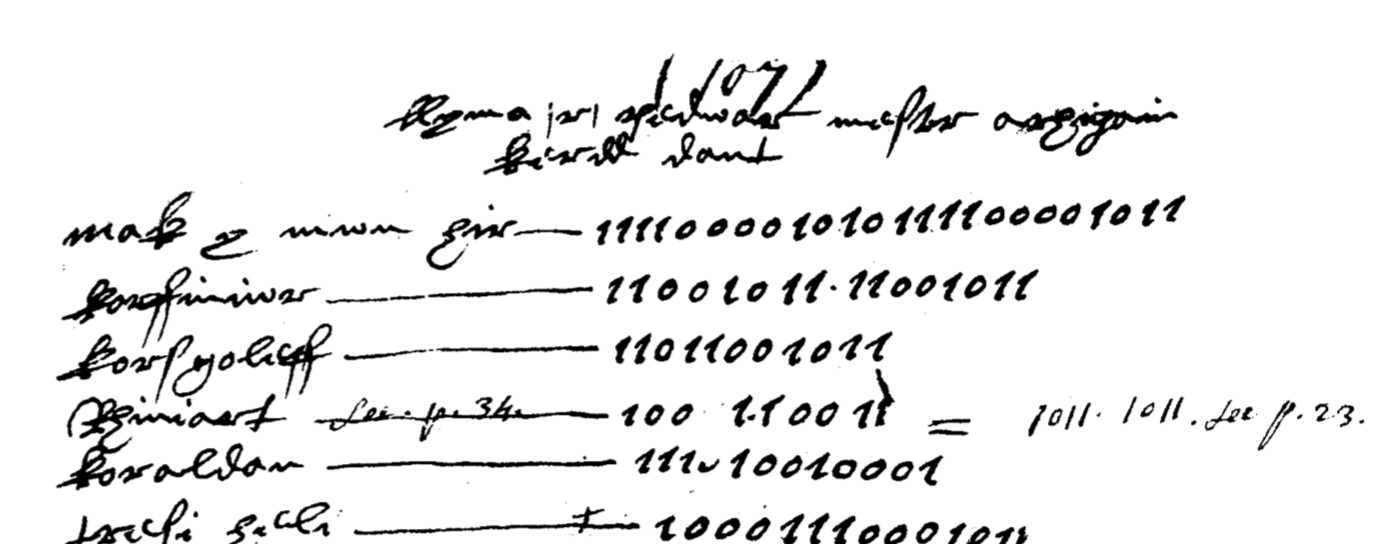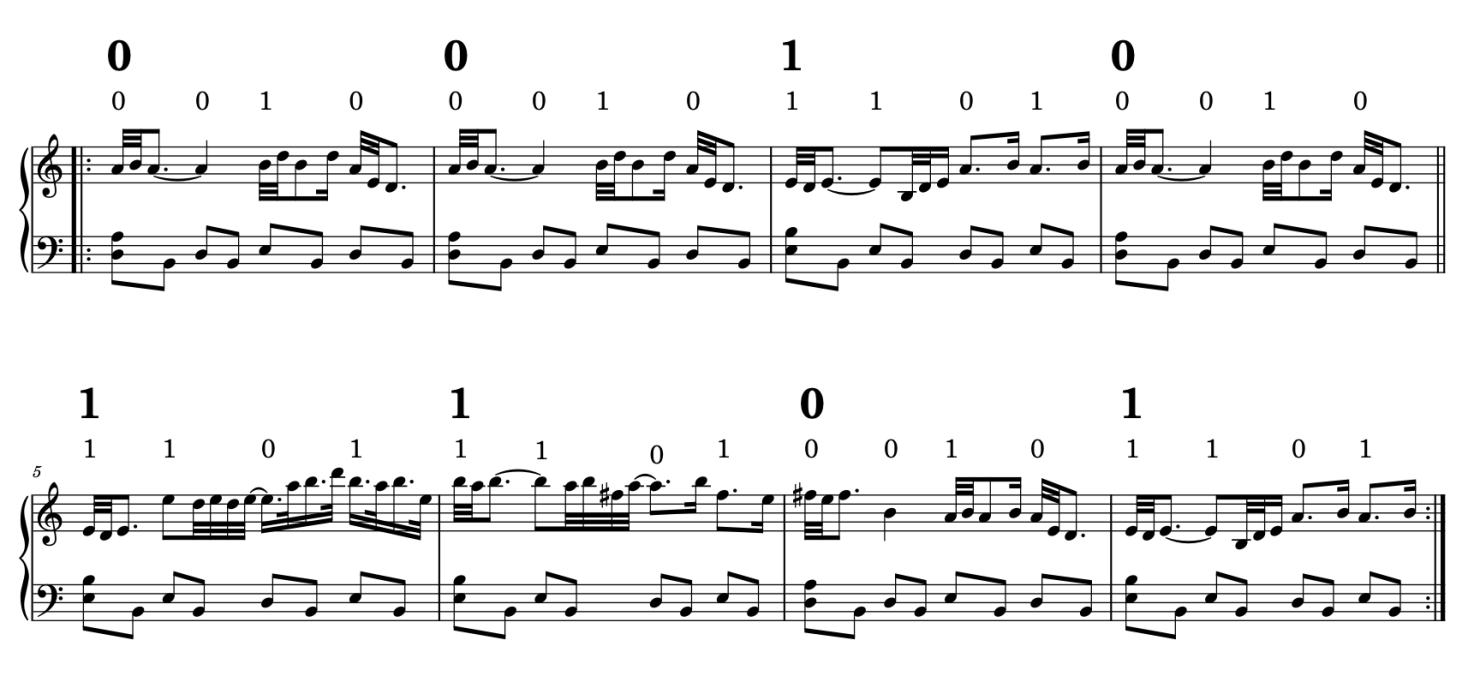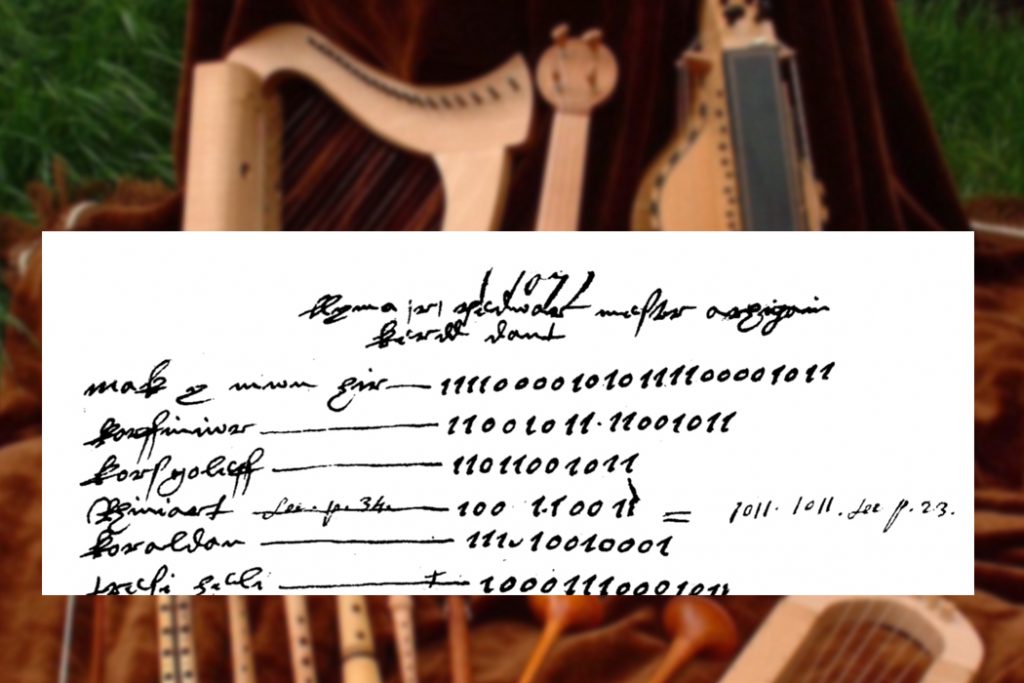
+ Welcome to Soundfly! We help curious musicians meet their goals with creative online courses. Whatever you want to learn, whenever you need to learn it. Subscribe now to start learning on the ’Fly.
In 1623, a Welsh guy sat down and wrote some binary code:

No, he wasn’t a software developer, four centuries ahead of his time; he was a harp player, very much of his time — these codes portray a beautifully medieval sensibility. Two harmonies alternate back and forth in intricate patterns, like woven tartan cloth or a Celtic knot.
This post explores these woven patterns, which anyone can use to make music. The patterns are intricate, yet simple. You can fit any sound or musical idea into each “1” and each “0.” Any chord, progression, rhythmic pattern, or tune, whether just a couple of notes or longer phrases, will work. Then lay it out according to the pattern, tweak it to make sure it’s not too mechanical, and sit back to enjoy luscious expanses of interesting, ever-changing music.
This can be a great tool for songwriters and lyricists looking for alternatives to standard formats (i.e., verse-chorus, verse-chorus…). Take a couple of phrases and alternate them according to one of these patterns, and you’ll get some lovely fresh moments of contrast in your songs. The patterns are a fun way to structure lyrics, too. They can serve as rhyme schemes, each 1 or 0 as a rhyming line ending, perhaps evolving to new rhymes as the song progresses. And the same goes for alliteration.
Let’s dig in deeper to see how these patterns work, and worked back then.
Binary Code: Symmetry and Inversion in Medieval Welsh Harp Music
Welsh harpist Robert ap Huw’s 1623 manuscript laid out a system of music and memory called the 24 measures of cerdd dant [string music]. The “binary code” portrays two chords or tonalities:
- 1 = string of “concord”
- 0 = string of “inflection”
For example, the Welsh measure “bryt odidog“: Each four is the inversion of the other:
0 0 1 0 * 0 0 1 0
1 1 0 1 * 1 1 0 1
I highly recommend listening to Bill Taylor’s re-creation of tunes from the Robert ap Huw manuscript. These patterns exist throughout Celtic music and beyond. In this Irish tune, listen for the pattern of alternating tonalities:
1 1 1 0 (repeated)
0 0 0 1 (repeated)
The second inverts the first.
Limited material, big possibilities: these musicians loved to work with strict limitations. A ten-minute tune with only four notes? No problem! Just make two contrasting musical ideas, then build them into a pattern of 1s and 0s, and you’ll have music of endless variety and interest.
Fractal Music: Broad Cloth from Little Stitches
The patterns we’ve looked at so far are short. But, like fractals, these small elements can combine into broad expanses of music. Here are the two parts of the Welsh measure “bryt odidog” again:
0 0 1 0 * 1 1 0 1
The first part is mostly 0s, and the second is mostly 1s. So let’s call the first a “big 0” and the second a “big 1:”
0 0 1 0 = “big 0”
1 1 0 1 = “big 1”
Now let’s recreate the original pattern, but using our “big 0” and “big 1.” The small, local pattern continues, but altered: It is now guided by the bigger pattern.

To demonstrate the effects of this pattern, with limited musical material, I made up a fake medieval Welsh harp song in the style of the tunes in the 1623 Robert ap Huw manuscript, as played by Bill Taylor. My song uses only four notes: D, E, A and B, plus one special note, F#, saved up for a key moment and used sparingly.
The large 1s and 0s show the overall Welsh measure “bryt odidog.” The small 1s and 0s show the pattern within each bar (heard in lower part). So the same pattern applies at two levels: fractal music! (Listen below.)

The phrases of my melody are not that interesting on their own, and the accompaniment is simple and repetitive. But you may find that the music sounds like it’s continually evolving and changing. There are moments when you expect one thing, and something else happens. The pattern of 1s and 0s won’t guarantee the right balance of surprise and satisfaction — that’s always going to happen in the artistry of composing — but it’s a wonderful and fun compositional tool you can add to your kit.
Woven Patterns in Pibroch, the “Big Music” of the Highland Bagpipe
Weaving small bits into larger patterns, using limited pitches, is the essence of pibroch – the Baroque-era classical music of the highland bagpipe of the Gaelic people of Scotland. (Gaelic spelling is piobaireachd).
16th – 18th centuries:
Gaelic-speaking, ceremonial music for war, sailing, mourning, saluting, etc.
19th – 21st centuries:
Anglicized, rarely heard, played mostly in stuffy piping competitions.
Pibroch uses woven patterns of consonance and dissonance against the drone. Let’s go back to the Welsh harp measure “bryt odidog:”
0 0 1 0 1 1 0 1
It’s the same as the “woven” pattern in pibroch, except with the 1s and 0s switched:

So, what do “1” and “0” mean in pibroch?
Each digit 1 or 0 is one phrase or group of phrases in the tune; the “one-ness” or “zero-ness” of a phrase comes from whether the main melody notes in that phrase are consonant or dissonant with the bagpipe drone.
- Bagpipe Drone note: A (mixolydian scale on A, with two sharps, though it may sound at closer to a B♭)
- Consonant notes: A, C#, E
- Dissonant notes: G, B, D
Canntaireachd (chanting)
Pibroch is taught by a sung solfège system. Each pitch, and each grace-note ornament, has its own syllable. In this video of canntaireachd being sung by Barnaby Brown, A stands for 1 and B stands for 0.
The dissonance or consonance of a phrase is often defined by its last note.
A Pibroch Tune
Here are the opening notes of one of the greatest pibrochs, Lament for the Viscount of Dundee.

The drone is A. Red stands for dissonant phrases, and blue for consonant phrases
This video shows the uninspiring atmosphere of many piobaireachd competitions.
The tune itself, before the variations start, is 2.5 minutes long. The full, detailed structure of the tune looks like this.
0 0 1 1 0 1 0 0
(0:39 in the video)
0 0 1 1 0 1 0 0
(1:18 in the video)
1 1 0 0 0 0 0 1
(1:54 in the video)
0 1 0 0 1 0 1 1
Let’s zoom out on that detailed, phrase-to-phrase pattern to see the birds-eye view, the overall guiding pattern. We can do this the same way we did above: by taking each pair of phrases and summarizing it as one “big 0” or one “big 1:”
if: 00 and 01 = big 0
and: 11 and 10 = big 1
Then we can capture the whole pattern more succinctly:
0 1 0 0 0 1 0 0 1 0 0 0 0 0 1 1
Remember the map of pibroch patterns earlier? This tune is the lyrical well-woven pattern, with the digits inverted (every 1 becomes a 0 and vice versa) and a slight variation in the fifth eighth of the tune:

In many pibroch tunes, something different happens in the fifth eighth of the tune — a new phrase or turn to freshen the ear. Often, a specific pitch is saved up for a special moment, occurring only once, as with the poignant F# toward the end of Lament for the Viscount of Dundee.
That Same Pibroch Tune, Stolen and Redone
For my composition Hudson Running, commissioned by Vassar College in 2011, I stole that pibroch tune as a starting point, using the same pattern of 1 and 0 sonorities, but inverted. For each phrase defined/dominated by “1” pitches A, C# and E (consonant with the drone), I switched them for “0” pitches G, B, and D (dissonant with the drone). For each “0” phrase I likewise inverted the pitches.

Then I made a few tweaks, added winds and piano to capture the highland pipes’ overtones, as well as a steady beat, and we get this:
So, what other well-woven music will these patterns help us create?
Improve all aspects of your music on Soundfly.
Subscribe to get unlimited access to all of our course content, an invitation to join our members-only Slack community forum, exclusive perks from partner brands, and massive discounts on personalized mentor sessions for guided learning. Learn what you want, whenever you want, with total freedom.
—
 Robinson McClellan is a composer, writer, and teacher. His music has been performed, commissioned, and published widely. He has done artist residencies at MacDowell and Yaddo and earned his doctorate in composition from Yale. He works in product development, user care/feeding, and instructional design for music and education companies. He founded and directs ComposerCraft, a workshop for young composers.
Robinson McClellan is a composer, writer, and teacher. His music has been performed, commissioned, and published widely. He has done artist residencies at MacDowell and Yaddo and earned his doctorate in composition from Yale. He works in product development, user care/feeding, and instructional design for music and education companies. He founded and directs ComposerCraft, a workshop for young composers.




